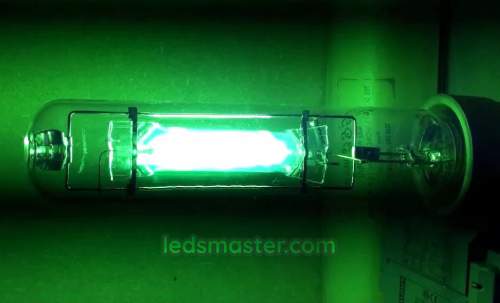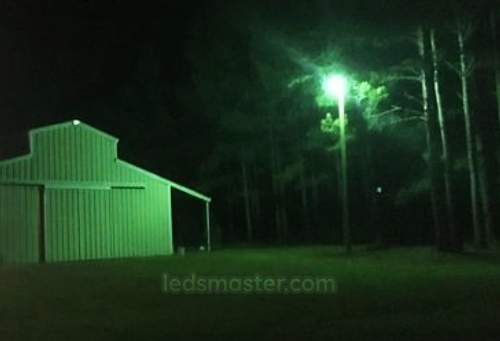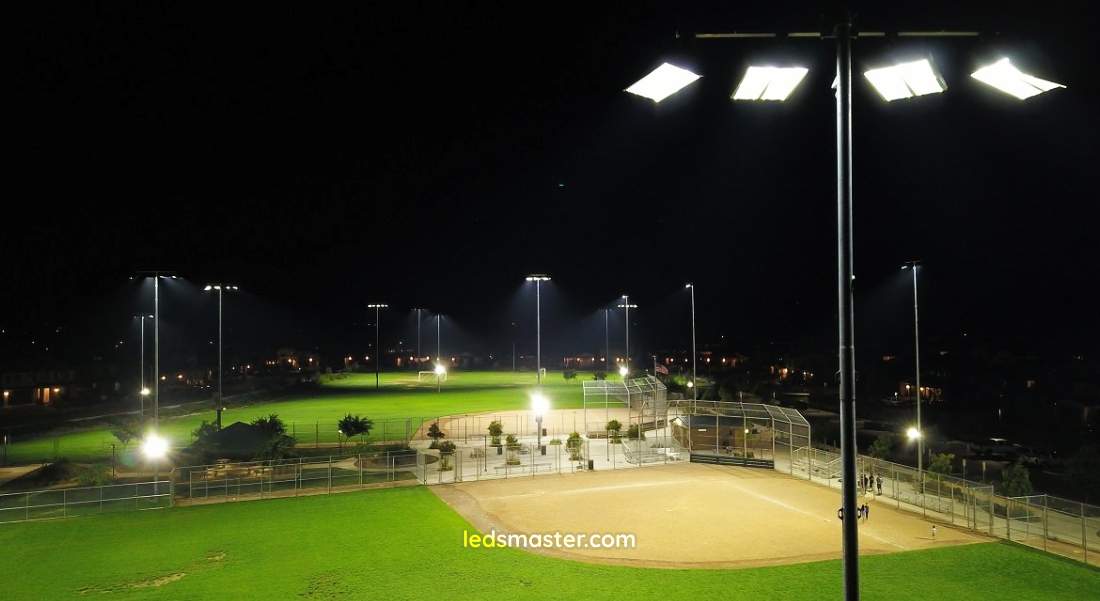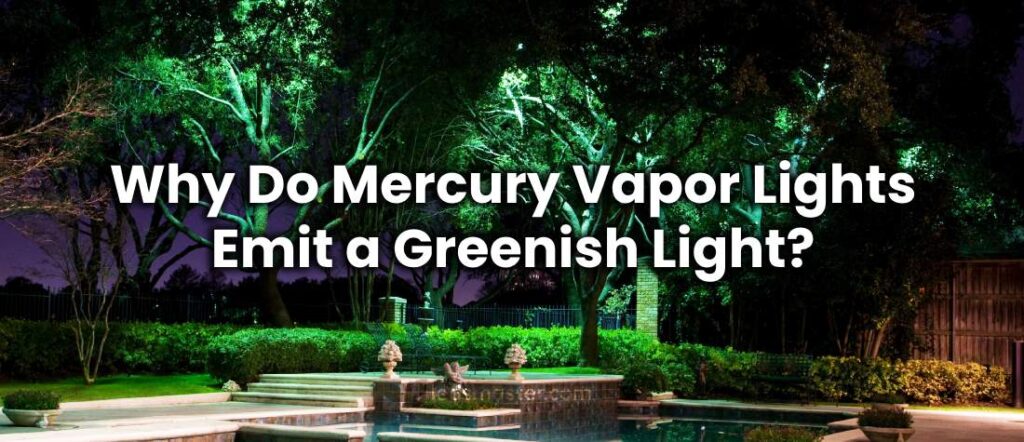Mercury vapor lights, a type of high-intensity discharge (HID) lamp, are known for their distinctive color characteristics. One of the most notable features of these lamps is their emission of a greenish-tinted light. This phenomenon is a result of the way mercury vapor lamps produce light and the specific properties of the gases and materials involved.
Table of Contents
ToggleThe Mechanism of Light Production in Mercury Vapor Lamps
 Mercury vapor lamps are known for their distinctive greenish light, a characteristic that can be intriguing when compared to other lighting technologies. This greenish hue results from the complex interplay between the lamp’s construction, the behavior of mercury vapor, and the phosphor coating used inside the lamp. Let’s delve into the detailed processes that lead to this unique color output.
Mercury vapor lamps are known for their distinctive greenish light, a characteristic that can be intriguing when compared to other lighting technologies. This greenish hue results from the complex interplay between the lamp’s construction, the behavior of mercury vapor, and the phosphor coating used inside the lamp. Let’s delve into the detailed processes that lead to this unique color output.
Arc Discharge
At the core of a mercury vapor lamp’s operation is the electric arc created when an electric current passes through the lamp’s internal mercury vapor. This arc ionizes the mercury atoms, exciting them to higher energy states. As the mercury atoms return to their lower energy states, they emit ultraviolet (UV) light. This UV light is crucial because, while it’s invisible to the naked eye, it forms the foundation of the visible light that the lamp ultimately produces.
Phosphor Coating
The interior of a mercury vapor lamp is coated with a phosphor material designed to convert UV light into visible light. The phosphor absorbs the UV radiation generated by the arc and re-emits it as visible light. The type and composition of the phosphor coating significantly influence the final color of the emitted light. Different phosphors can produce various color temperatures and hues, but in mercury vapor lamps, the phosphor’s ability to fully neutralize the green and blue emissions from the mercury vapor is limited.
The Greenish Tint of Mercury Vapor Light
The greenish tint of mercury vapor light arises from the combination of the spectral output of the mercury vapor and the phosphor coating.
Spectral Output
Emission Lines of Mercury
Mercury vapor lamps generate light through an electrical discharge within a tube containing mercury vapor and an inert gas. When the electric arc excites the mercury atoms, they emit light at specific wavelengths. Mercury vapor has prominent emission lines in the visible spectrum, particularly around 435.8 nanometers (nm) in the blue range and 546.1 nm in the green range. The green emission line, being relatively strong, plays a significant role in the lamp’s overall color output.
Dominant Green Wavelength
Among these emission lines, the green line at 546.1 nm is notably intense. This wavelength contributes heavily to the color of the light produced by the lamp. Although the blue emission at 435.8 nm also affects the light’s appearance, the green wavelength is strong enough to impart a noticeable greenish tint to the emitted light. The combination of these wavelengths results in a light output that is less balanced and more biased toward the green part of the spectrum.
Phosphor Efficiency
Role of Phosphor Coating
To transform ultraviolet (UV) light into visible light, mercury vapor lamps are coated internally with a phosphor material. This phosphor absorbs UV radiation generated by the electric arc and re-emits it as visible light. The effectiveness of the phosphor in converting UV light into a broader spectrum of visible light impacts the final color of the light.
Conversion Limitations
Despite its role, the phosphor coating in mercury vapor lamps may not be highly effective at neutralizing the strong green and blue emissions from the mercury vapor. The phosphor’s ability to counterbalance these wavelengths is limited, resulting in light that retains a greenish tint. The inefficiency in achieving a balanced white light is one reason why mercury vapor lamps often appear cooler and greener compared to modern lighting solutions.
Light Color Temperature
Typical Color Temperature
Mercury vapor lamps typically have a color temperature ranging from 4,000 to 5,000 Kelvin. This color temperature corresponds to a cooler, bluish-white light. However, the strong green emission lines from the mercury vapor can influence the perceived color temperature, making the light appear more greenish than other sources with similar color temperatures.
Impact on Light Perception
The inherent green hue in the light output becomes more pronounced when compared to the warmer tones of other lighting technologies. The cooler color temperature associated with mercury vapor lamps, combined with the dominant green spectral lines, creates a lighting effect that can be visually distinct and less neutral than newer technologies like LEDs and high-pressure sodium lamps.
Implications of the Greenish Light
Visibility and Aesthetics
 The greenish tint produced by mercury vapor lamps affects color rendering and overall visual perception. The lower color rendering index (CRI) of these lamps means that colors are not as accurately represented as they are under other lighting sources. This can impact the appearance of objects and spaces, particularly in applications where color accuracy is important.
The greenish tint produced by mercury vapor lamps affects color rendering and overall visual perception. The lower color rendering index (CRI) of these lamps means that colors are not as accurately represented as they are under other lighting sources. This can impact the appearance of objects and spaces, particularly in applications where color accuracy is important.
Application Suitability
Despite their greenish hue, mercury vapor lamps continue to be used in certain applications where their lighting characteristics are acceptable or even desired. However, the advancement of lighting technology has led to the development of alternatives that offer better color rendering and more natural light. Modern solutions such as LEDs provide improved performance and eliminate the greenish tint, offering a more balanced and aesthetically pleasing illumination.
Transition to New Technologies
The limitations of mercury vapor lamps in terms of color quality and efficiency have spurred the adoption of newer lighting technologies. LEDs and high-pressure sodium lamps, for example, provide more accurate color rendering and greater energy efficiency without the greenish hue associated with mercury vapor lamps. As lighting technology evolves, these alternatives become increasingly preferred for both their performance and visual appeal.
Advantages of Replacing Mercury Vapor Lights with LED Lighting

Enhanced Energy Efficiency
One of the primary benefits of replacing mercury vapor lights with LED lighting is the significant improvement in energy efficiency. Mercury vapor lamps are known for their high energy consumption, which translates into higher electricity bills. In contrast, LED lights are designed to consume a fraction of the energy required by mercury vapor lamps. This increased efficiency means that LED lights can produce the same amount of light while using less power, resulting in substantial cost savings over time.
Longer Lifespan
Another key advantage of LEDs over mercury vapor lights is their extended lifespan. Mercury vapor lamps typically have a lifespan ranging from 24,000 to 28,000 hours. However, LED lights can last up to 100,000 hours, depending on the quality and application. This extended operational life reduces the frequency of replacements and maintenance, which further contributes to cost savings and less downtime.
Improved Light Quality
LEDs provide superior light quality compared to mercury vapor lights. Mercury vapor lamps tend to emit a dim, bluish light with poor color rendering capabilities, which can affect visibility and aesthetics. LEDs, on the other hand, offer a bright, clear light with excellent color rendering, making it easier to see and distinguish objects. This improved light quality enhances safety and comfort in various settings, from outdoor areas to indoor spaces.
Reduced Environmental Impact
Replacing mercury vapor lights with LEDs also has significant environmental benefits. Mercury vapor lamps contain mercury, a hazardous substance that can pose environmental and health risks if not disposed of properly. In contrast, LEDs do not contain mercury or other harmful materials, making them a more environmentally friendly option. Additionally, the energy efficiency of LEDs helps reduce greenhouse gas emissions by decreasing the overall demand for electricity.
Lower Heat Emission
Mercury vapor lights generate a considerable amount of heat during operation, which can contribute to higher cooling costs and potentially impact the lifespan of nearby equipment. LEDs, however, produce minimal heat compared to mercury vapor lamps. This lower heat emission not only improves the overall efficiency of lighting systems but also helps maintain a more comfortable environment and reduces the strain on cooling systems.
Cost Savings
The financial benefits of switching from mercury vapor lights to LEDs are substantial. While the initial investment in LED lighting may be higher, the long-term savings are significant. LEDs’ energy efficiency leads to lower electricity bills, and their extended lifespan reduces replacement and maintenance costs. Over time, these savings can offset the upfront costs and result in a more cost-effective lighting solution.
Enhanced Durability
LED lights are known for their durability and resilience. Unlike mercury vapor lamps, which can be fragile and prone to breakage, LEDs are designed to withstand various environmental conditions, including vibrations and impacts. This durability makes LEDs a more reliable choice for both indoor and outdoor applications, reducing the risk of damage and the need for frequent replacements.
Instant Light and Dimmability
LED lights provide instant illumination without the warm-up time required by mercury vapor lamps. This feature is particularly beneficial in applications where immediate lighting is essential. Additionally, many LED systems offer dimmability options, allowing for adjustable light levels to suit different needs and preferences. This versatility enhances the functionality and adaptability of lighting systems.
Conclusion
The greenish light emitted by mercury vapor lamps is a result of the spectral properties of mercury vapor and the limitations of the phosphor coating used in the lamps. While this characteristic can impact the quality and appearance of the light, understanding the underlying mechanisms helps explain why these lamps produce their distinctive hue.
As lighting technology advances, switching to more modern solutions like LEDs presents clear benefits. LEDs offer significant advantages over mercury vapor lights. They provide superior energy efficiency, longer lifespans, and better color rendering. LEDs also eliminate the environmental hazards associated with mercury and reduce overall energy consumption, leading to lower electricity bills and less frequent maintenance. As a result, transitioning to LEDs is a practical and eco-friendly choice for modern lighting needs.

